

How to Write Guide: Making Tables and Figures. Definitions | Getting Organized | Referencing from Text | Abbreviation of "Fig.

" | Numbering Figures and Tables | | Placement in paper | Legends | Legend Postion | Anatomy of a table | Anatomy of a graph | | Compound Figures | Bar Graphs | Frequency Histograms | Scatterplots | Line Graphs | | More examples | Once your statistical analyses are complete, you will need to summarize the data and results for presentation to your readers. Data summaries may take one of 3 forms: text, Tables and Figures. Organizing your presentation: Once you have done your analyses and decided how best to present each one, think about how you will arrange them. Your analyses should tell a "story" which leads the reader through the steps needed to logically answer the question(s) you posed in your Introduction.
The order in which you present your results can be as important in convincing your readers as what you actually say in the text. Figure 9. Notice here that: A photograph is a figure. Top of Page. Dragonfly Stats Q&A. Unit Plan: Teaching the Nature of Science - What Science is NOT. What Science is NOT 1.
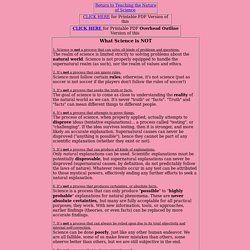
Science is not a process that can solve all kinds of problems and questions. The realm of science is limited strictly to solving problems about the natural world. Science is not properly equipped to handle the supernatural realm (as such), nor the realm of values and ethics. 2. 3. 4. 5. 6. Science Knowledge Survey. Science Knowledge Survey Introduction A recent study shows that if teachers know the likely misconceptions that their students have about a topic, those students will show greater gains than if the teacher just knows the accurate science involved.
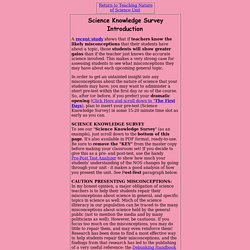
This makes a very strong case for assessing students to see what misconceptions they may have about each upcoming general topic. In order to get an untainted insight into any misconceptions about the nature of science that your students may have, you may want to administer a short pre-test within the first day or so of the course. Science Knowledge Survey. Schoolyard Habitats FAQs. Schools and organizations benefit from certifying their habitat projects in many ways.
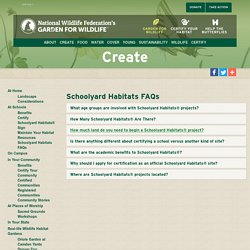
When a school gets certified, National Wildlife Federation sends the school a press release the school can send to local papers. This publicity helps schools gain additional community support and aids in future fundraising efforts for the schoolyard project. Once certified, schools are also able to order an attractive sign, which they can post to announce and describe their efforts. In addition, certified schools can receive an online newsletter specifically for educators, and benefit from belonging to this dynamic network of educators and schools involved in habitat restoration and hands-on outdoor instruction. Most people find that applying for certification is a helpful, tangible goal along the road of habitat restoration.
Resources. Creating a Schoolyard Habitat: How to Create, Maintain and Teach in an Outdoor Classroom - Are you ready to create a Schoolyard Habitat, but not sure how to start?

National Wildlife Federation's webinar covers special design and project planning considerations for installing a habitat on school grounds and utilizing a habitat for teaching. Designing Your Schoolyard Habitat Project - Have you ever considered creating or improving a school garden or creating a wildlife friendly outdoor classroom? Resources.
Barker Slingsby FSC 2002 teaching%20biology%20outside%20the%20classroom heading%20for%20extinction. Building Solitary Bee Nests. An Error Occurred Setting Your User Cookie. This site uses cookies to improve performance.

If your browser does not accept cookies, you cannot view this site. Setting Your Browser to Accept Cookies There are many reasons why a cookie could not be set correctly. Below are the most common reasons: You have cookies disabled in your browser. Why Does this Site Require Cookies? This site uses cookies to improve performance by remembering that you are logged in when you go from page to page.
What Gets Stored in a Cookie? This site stores nothing other than an automatically generated session ID in the cookie; no other information is captured. In general, only the information that you provide, or the choices you make while visiting a web site, can be stored in a cookie. An Error Occurred Setting Your User Cookie. Conservation Education Partnerships in Schoolyard Laboratories: A Call Back to Action on JSTOR.
Conservation Biology Description: In the past decade Conservation Biology has become the most influential and frequently cited journal in its field.
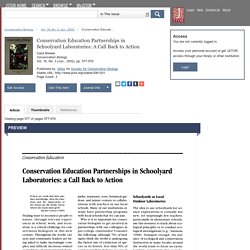
Nature calls this title "required reading for ecologists throughout the world. " The journal continues to publish groundbreaking papers and remains instrumental in defining the key issues contributing to the study and preservation of species and habitats. The Society for Conservation Biology and its members appreciate the increasing and alarming rate of species and habitat loss in our world and remain committed to the movement of conservation biology to the forefront of the sciences. Only by understanding the scientific basis of conservation can we effectively confront the extinction crisis. JSTOR provides a digital archive of the print version of Conservation Biology. Coverage: 1987-2005 (Vol. 1, No. 1 - Vol. 19, No. 6) Subjects: Ecology & Evolutionary Biology, Science & Mathematics, Biological Sciences × Close Overlay. ConEd Schoolyard Biodiversity Guide.
Wildlife. Wildlife habitat gardens will help smaller wildlife that can safely co-exist with people in our cities, towns and neighborhoods.
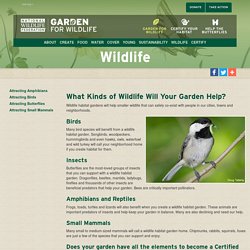
Birds Many bird species will benefit from a wildlife habitat garden. Songbirds, woodpeckers, hummingbirds and even hawks, owls, waterfowl and wild turkey will call your neighborhood home if you create habitat for them. Insects Butterflies are the most-loved groups of insects that you can support with a wildlife habitat garden. Featured Infographic: One-Tailed vs. Two-Tailed Tests.
FAQ: What are the differences between one-tailed and two-tailed tests? FAQ: What are the differences between one-tailed and two-tailed tests?
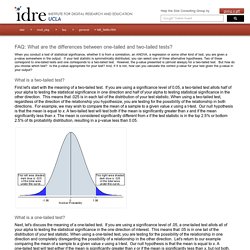
When you conduct a test of statistical significance, whether it is from a correlation, an ANOVA, a regression or some other kind of test, you are given a p-value somewhere in the output. If your test statistic is symmetrically distributed, you can select one of three alternative hypotheses.